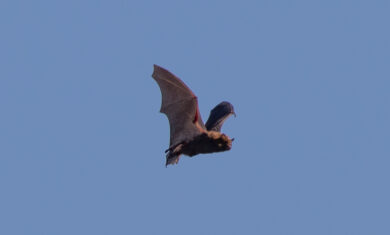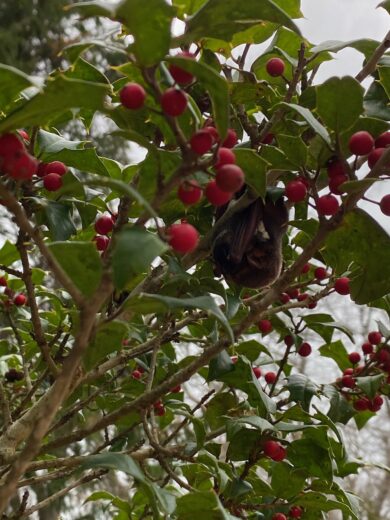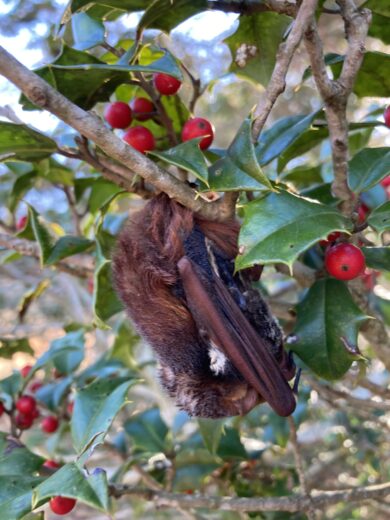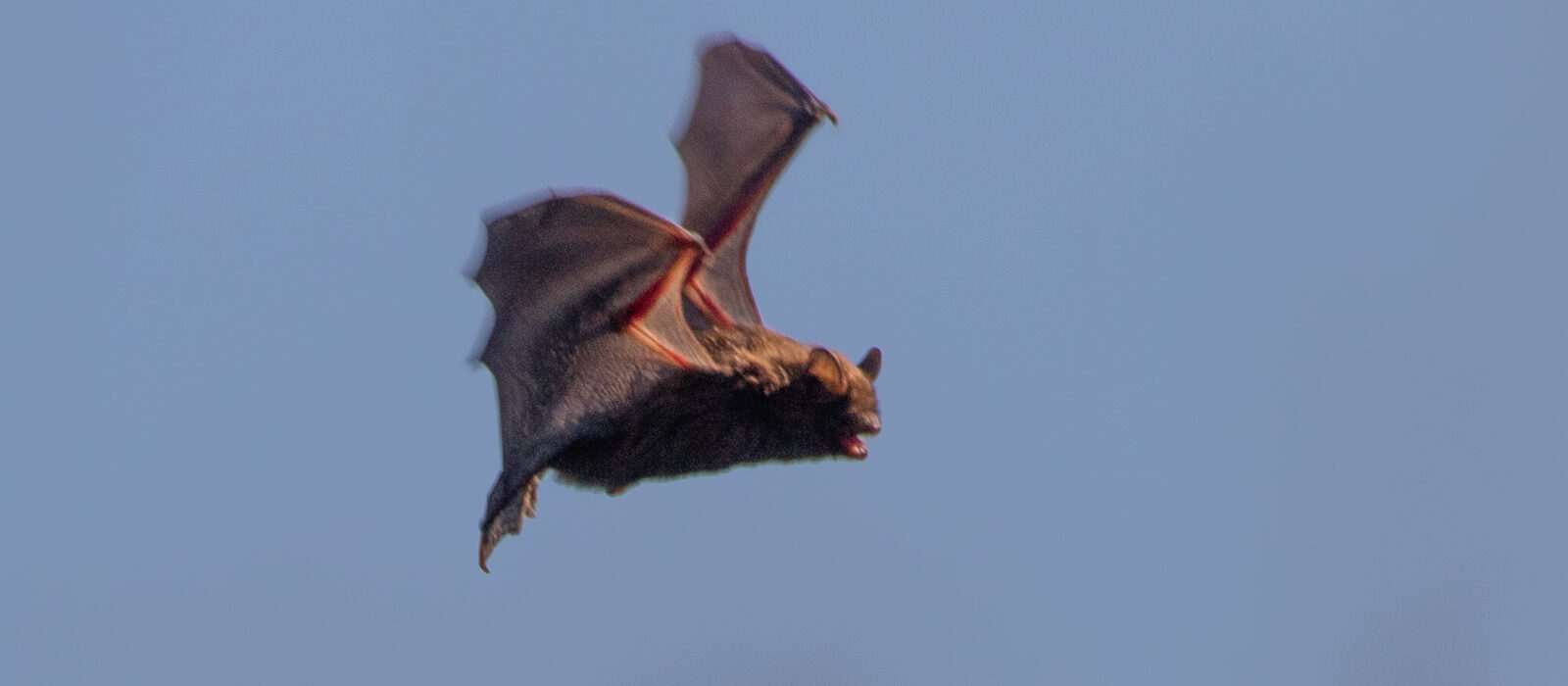
Silver-haired bat, Edgartown, Mass., December 14, 2023. Photo by Jeff Bernier
If you are a careful observer of the natural world, you have probably been rewarded at one time or another for taking a second look. This was recently the case for two local naturalists who were both startled by unusual December observations of migratory “tree bat” species.
On December 14, Jeff Bernier was birding at the Martha’s Vineyard Land Bank’s Sweetened Water Preserve in Edgartown. When he approached a wooded wetland pond, he happened upon a small flock of roosting black-crowned night herons, which flushed when he approached. While photographing the herons, Jeff noticed what he initially thought was a smaller bird flying around the pond. But when he turned his camera on it, he soon discovered that this “bird” was actually a bat! He was amazed to find a bat not just active so late in the season, but also flying around in broad daylight.
A few days later, on December 17, Lindsey Lee stopped to marvel at the berries on a holly tree and then noticed what she thought was a leaf from a different tree within the holly. But when she took a closer look, she was shocked to see it was a bat! Careful not to disturb it, Lindsey took several photos of this little mammal and sent them along to us to find out what kind of a bat might be sleeping in a tree this time of year.

Lindsey Lee found this sleeping Eastern red bat while admiring a holly tree. These bats migrate south for the winter.
We were delighted to receive these bat photos and offer some thoughts on their occurrence in December. Both of these bats are “tree bats” – species that typically roost in trees rather than in buildings or caves. Jeff’s bat was a silver-haired bat (Lasionycterus noctivangans). Weighing between nine and 15 grams, with a wingspan ranging from 28 to 33 cm (roughly a foot), these beautiful bats have fur that can vary from black to brown with silver-tipped hairs. They eat moths, true bugs, flies, mosquitoes, and termites, and are known for their slow flight pattern (which helped Jeff capture such great images of his bat).
We originally thought that Lindsey’s bat was a hoary bat (Lasiurus cinereus), but other bat biologists reviewed the photo on iNaturalist (the best way to find an expert’s help) and thought it was instead a red bat or perhaps even a Seminole bat (Lasiurus seminolus), a southern species, blown north in a storm. It isn’t often that you get to take a second look at a bat, but Lindsey reported the bat in question was still in the holly tree over the holiday weekend. So on January 2, Liz Olson found the bat from Lindsey’s directions and took more photos. The bat is alive and appears uninjured. These more recent photos show that it is a red bat (Lasiurus borealis), which shares the same genus as the hoary bat and exhibits some similar characteristics. Here is one of Liz’s images, showing the bat more clearly.

a red bat roosting in a holly tree on 01.02.24
The red bats we capture in our nets here in the summer and fall are typically all red with very little ‘frosting’ on their fur, so this bat confused us. Red bats are widespread in the East and have a western red bat counterpart species. Eastern red bats weigh between 9 and 15 grams with wings that span from 28 to 33 cm (11-13 inches). Like silver-haired bats, they also eat moths, true bugs, and mosquitoes, but they also take cicadas and crickets as well as other insects.
Sharing this observation on iNaturalist connected us with other bat biologists who have seen a broader range of coloring in red bats and noted the lack of a dark border on the ear of this bat (which is a key ID feature for hoary bat). Their questions set us on a quest for better photos and gave us the chance to correct our identification. This is a good reminder that you don’t need perfect photos to identify wildlife – just photos that show the critical details! Here is an iNaturalist observation of an eastern red bat in New York in 2018, also in December in a holly tree!
Both of these bat species migrate south for the winter, and the generally mild autumn we had likely explains why these two were still here. Silver-haired and Eastern red bats, as well as the Hoary bat, have been approved by the Massachusetts Natural Heritage and Endangered Species board for listing as Species of Special Concern in the state. While their migratory habits have saved them from the deadly white-nose syndrome that kills hibernating (as opposed to migratory) bats, these three species have suffered significant mortality from wind turbines . Their populations have declined precipitously across North America.
Thank you to Jeff and Lindsey for sharing their observations of these beautiful bats so that we could bring their stories to you!
Wildlife biologist Luanne Johnson is the co-founder and Executive Director of BiodiversityWorks.
